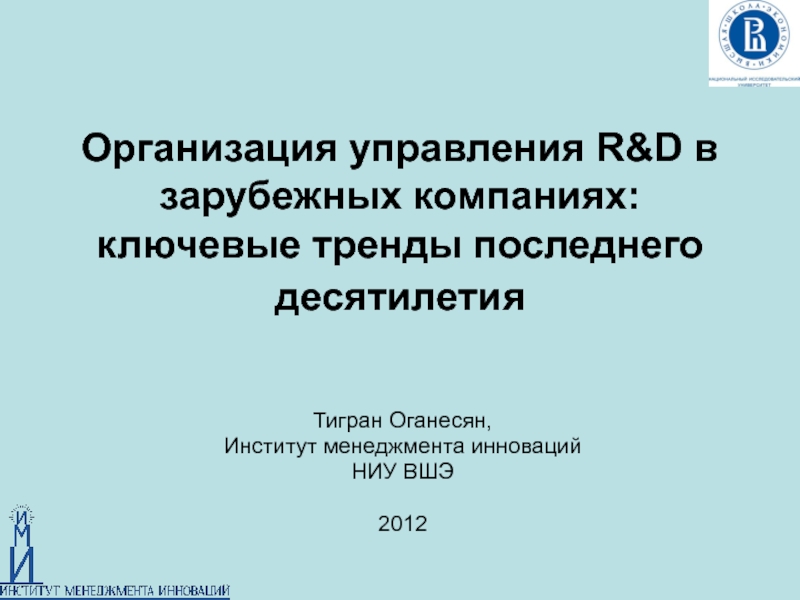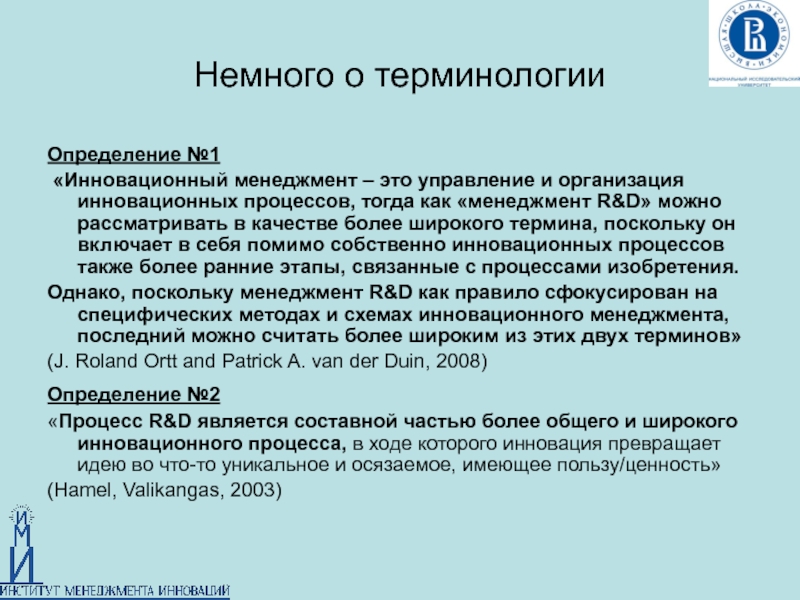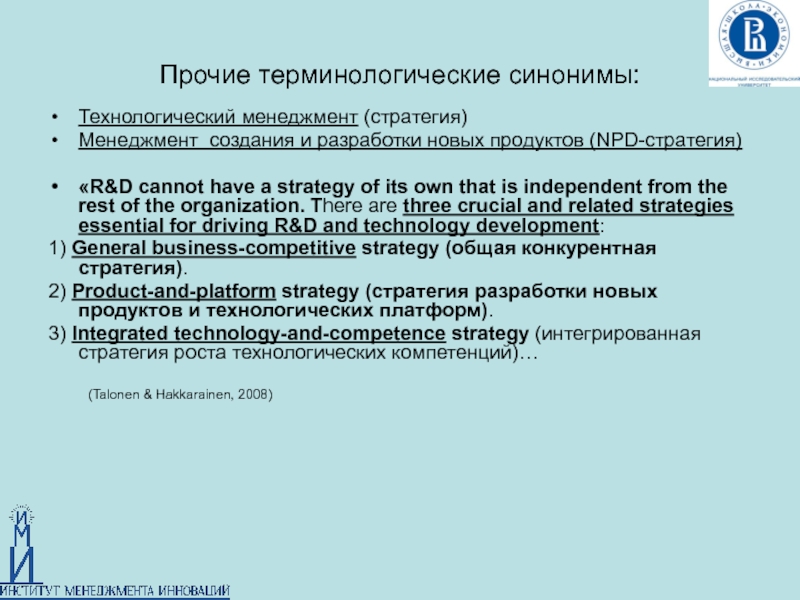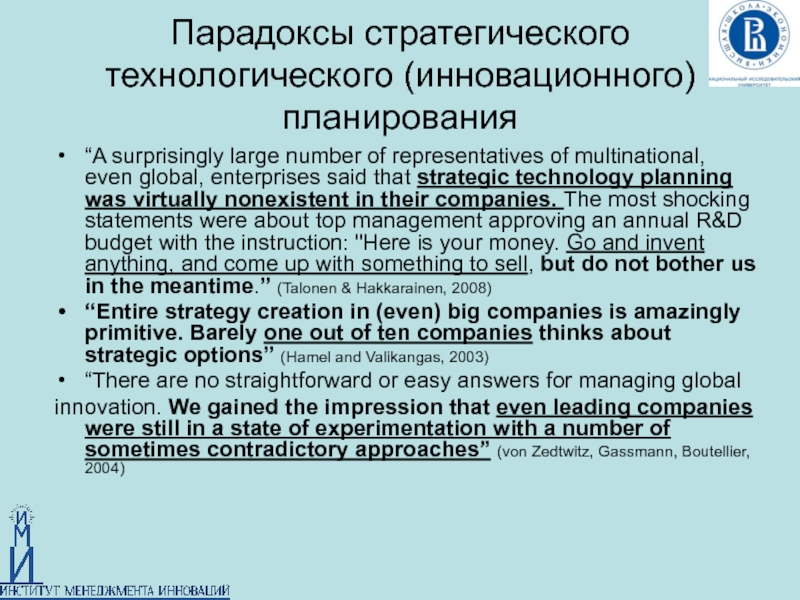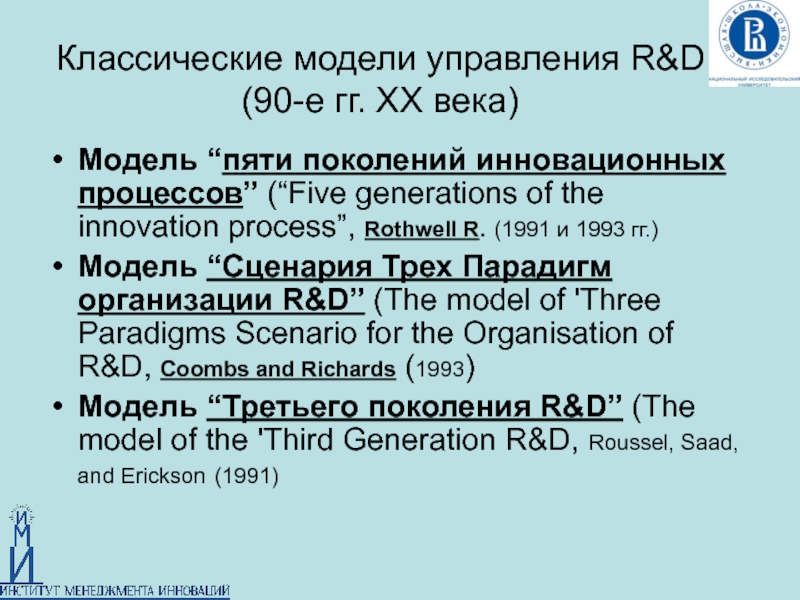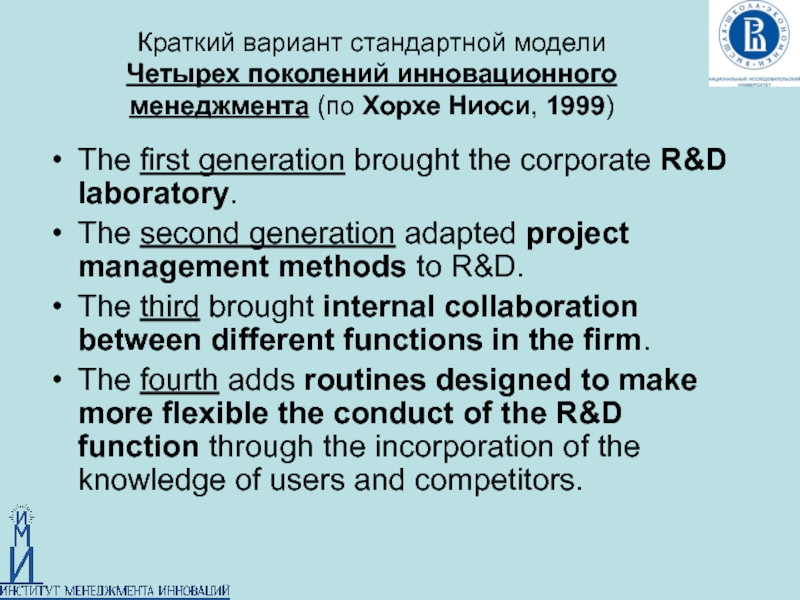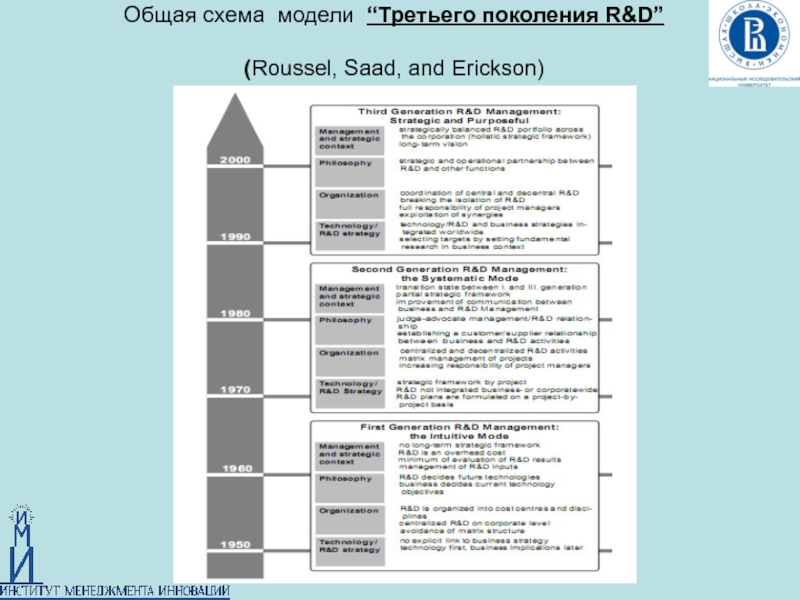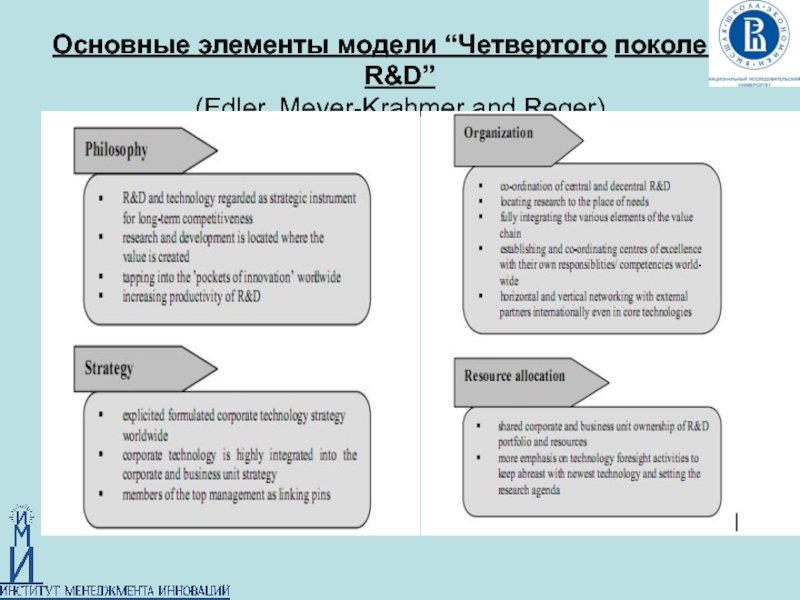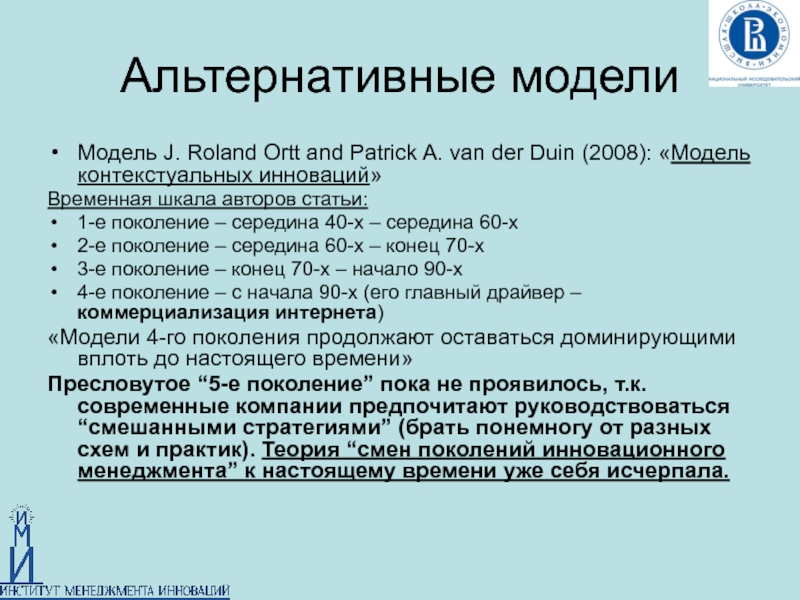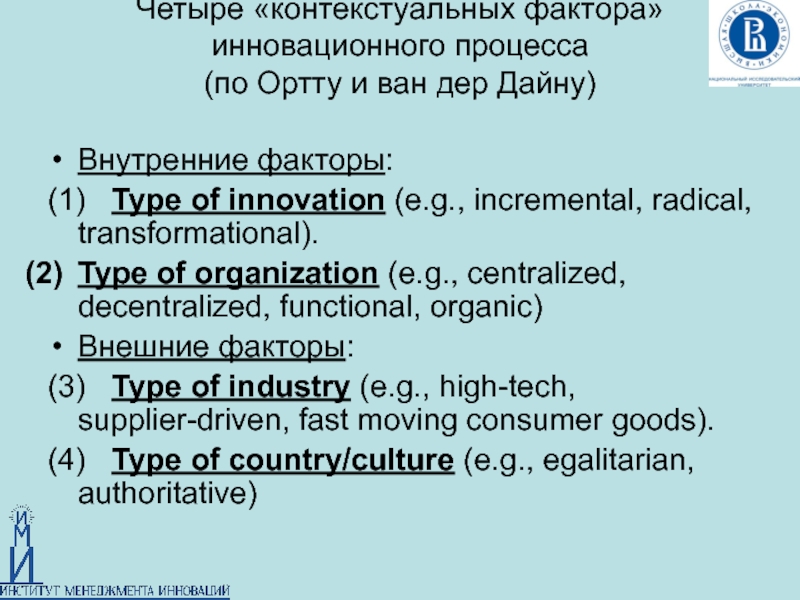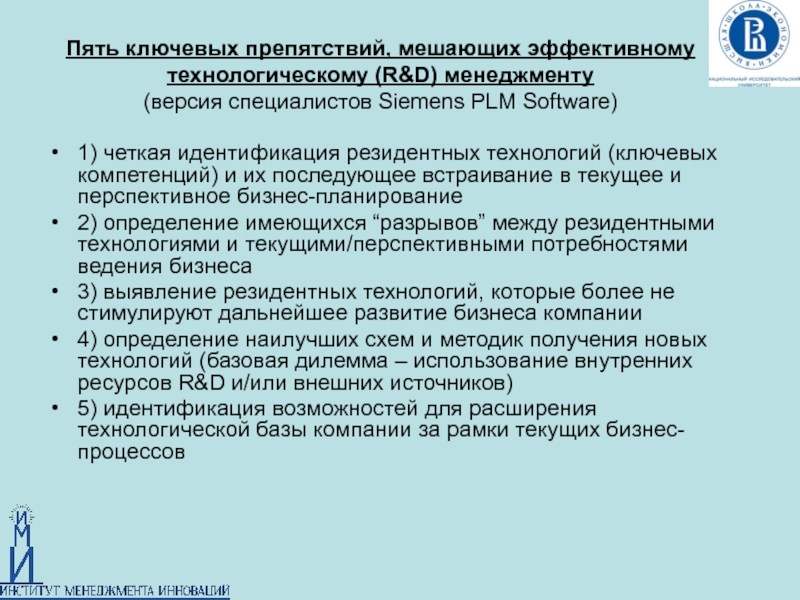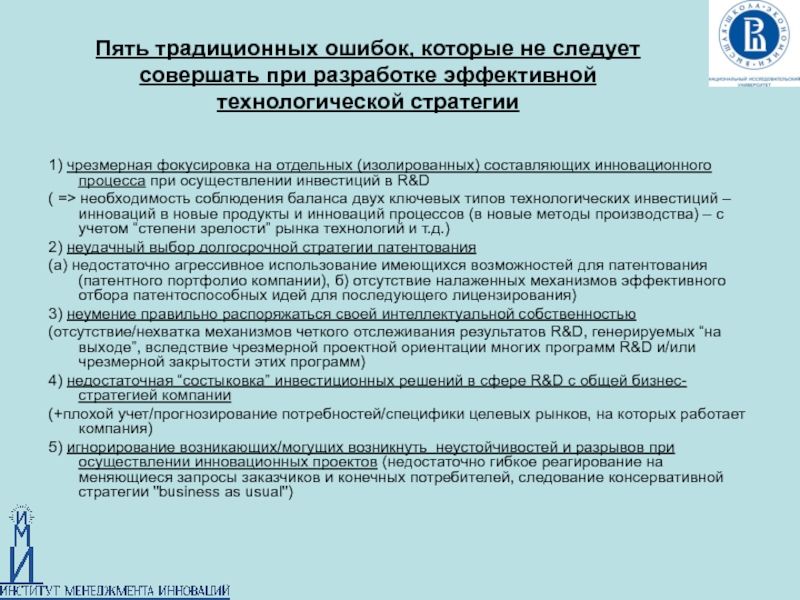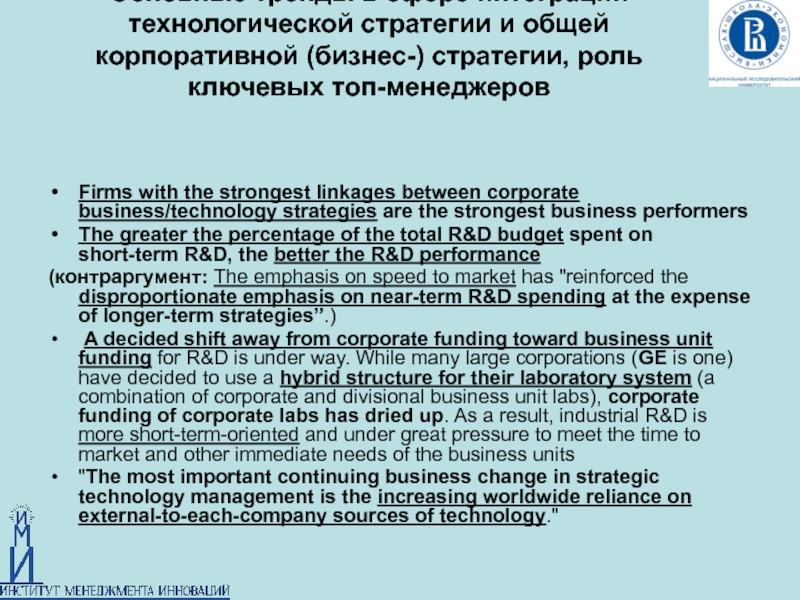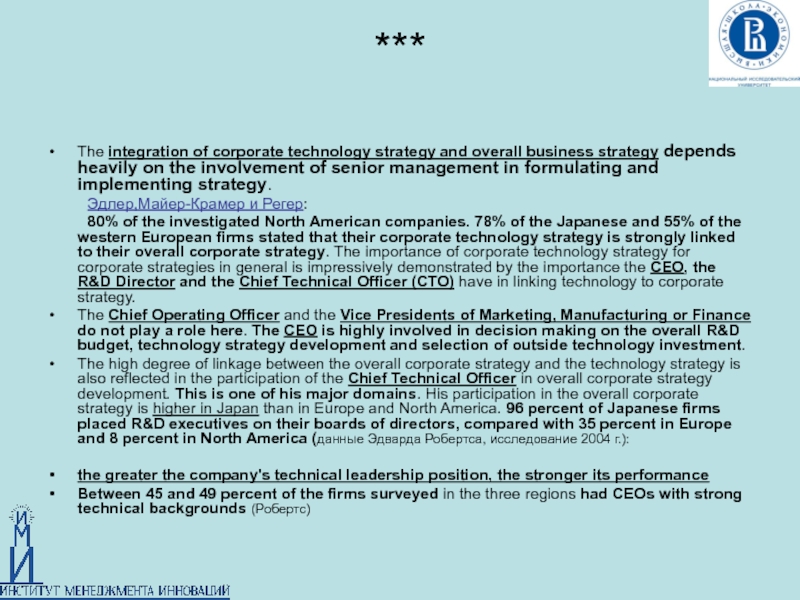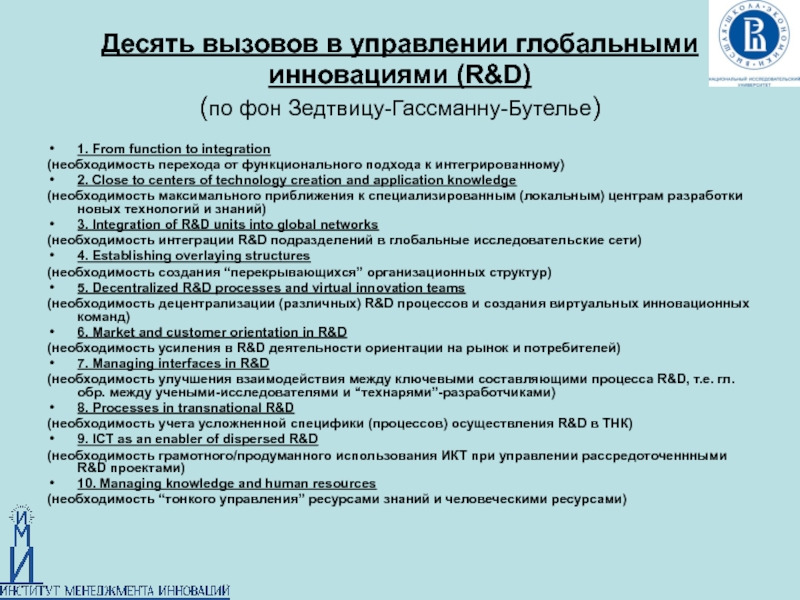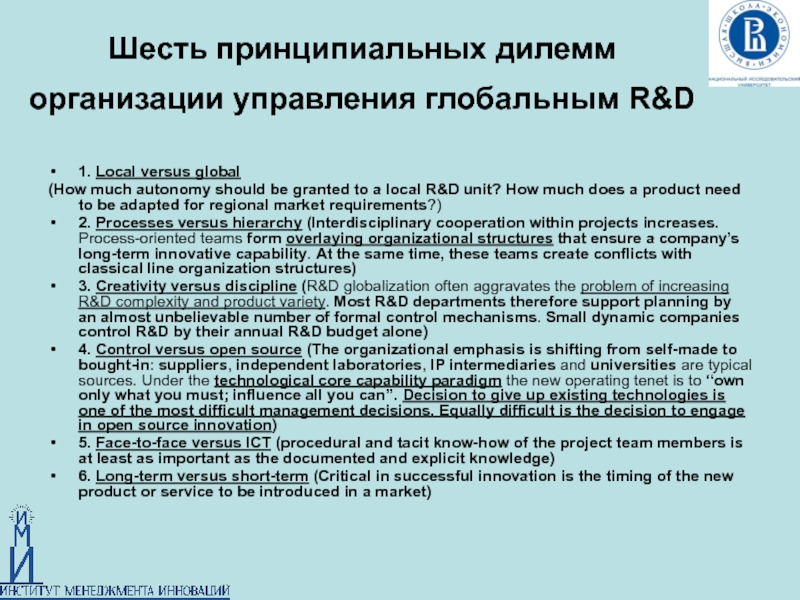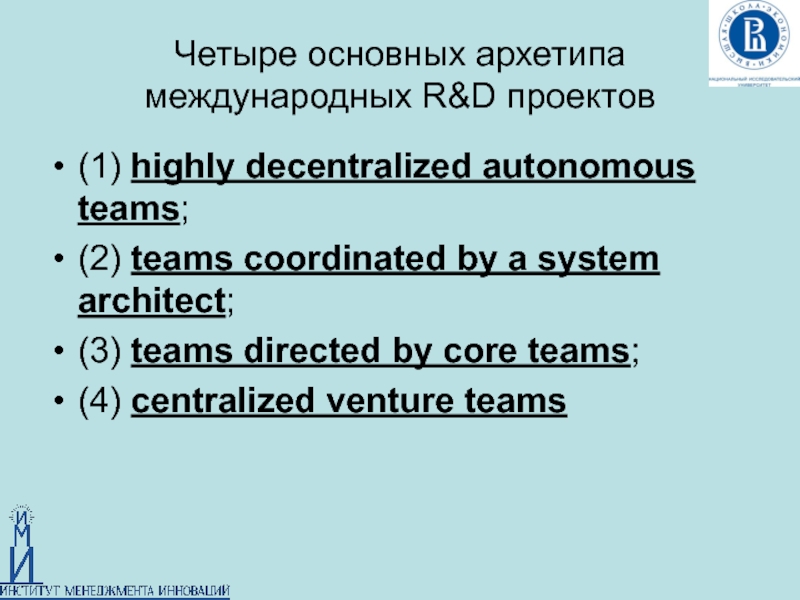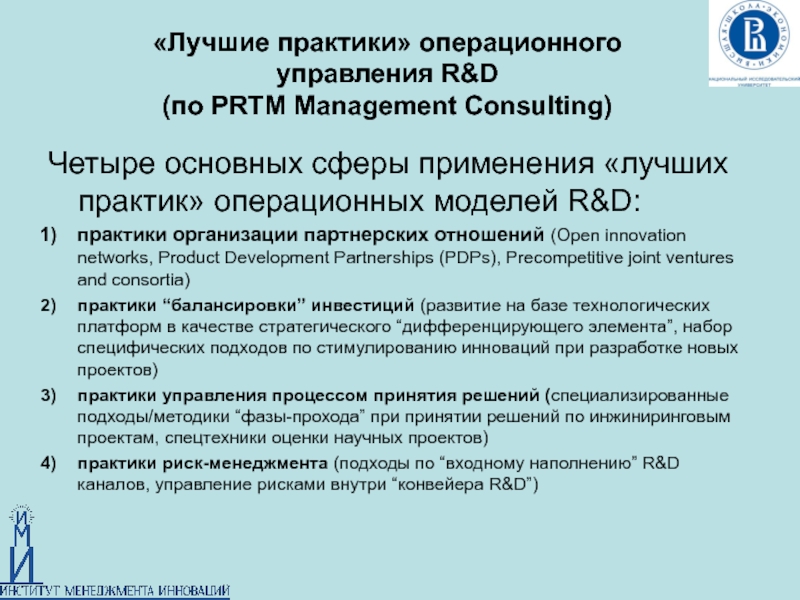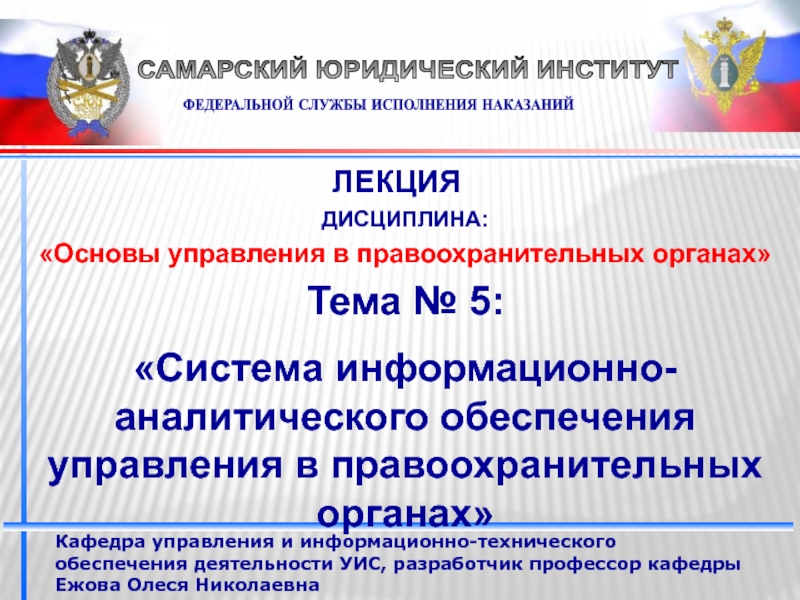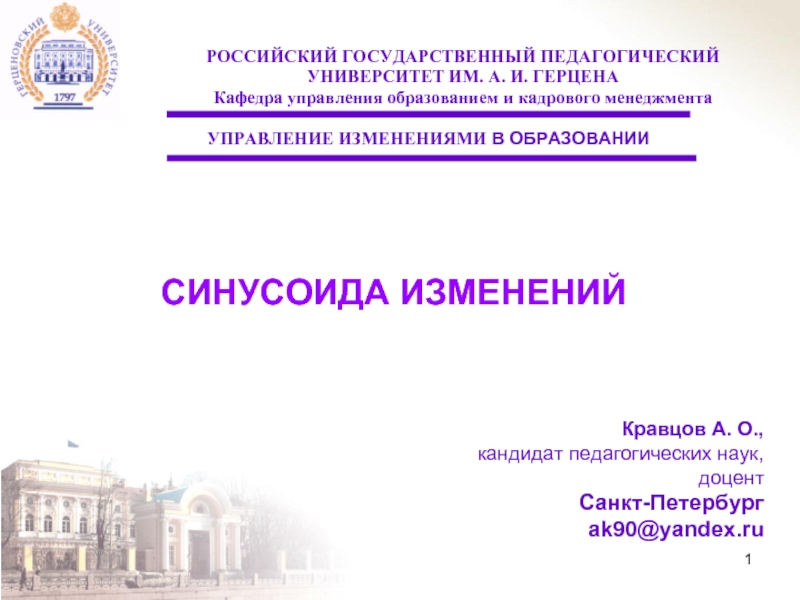- Главная
- Разное
- Дизайн
- Бизнес и предпринимательство
- Аналитика
- Образование
- Развлечения
- Красота и здоровье
- Финансы
- Государство
- Путешествия
- Спорт
- Недвижимость
- Армия
- Графика
- Культурология
- Еда и кулинария
- Лингвистика
- Английский язык
- Астрономия
- Алгебра
- Биология
- География
- Детские презентации
- Информатика
- История
- Литература
- Маркетинг
- Математика
- Медицина
- Менеджмент
- Музыка
- МХК
- Немецкий язык
- ОБЖ
- Обществознание
- Окружающий мир
- Педагогика
- Русский язык
- Технология
- Физика
- Философия
- Химия
- Шаблоны, картинки для презентаций
- Экология
- Экономика
- Юриспруденция
Организация управления R&D в зарубежных компаниях: ключевые тренды последнего десятилетия презентация
Содержание
- 1. Организация управления R&D в зарубежных компаниях: ключевые тренды последнего десятилетия
- 2. Немного о терминологии Определение №1
- 3. Прочие терминологические синонимы: Технологический менеджмент (стратегия) Менеджмент
- 4. Парадоксы стратегического технологического (инновационного) планирования “A surprisingly
- 5. Классические модели управления R&D (90-е гг. ХХ
- 6. Краткий вариант стандартной модели Четырех поколений инновационного
- 7. Общая схема модели “Третьего поколения R&D” (Roussel, Saad, and Erickson)
- 8. Основные элементы модели “Четвертого поколения R&D” (Edler, Meyer-Krahmer and Reger)
- 9. Альтернативные модели Модель J. Roland Ortt and
- 10. Четыре «контекстуальных фактора» инновационного процесса (по
- 11. Модель «стратегической переориентации промышленного R&D в сторону
- 12. Пять ключевых препятствий, мешающих эффективному технологическому (R&D)
- 13. Пять традиционных ошибок, которые не следует совершать
- 14. Основные тренды в сфере интеграции технологической стратегии
- 15. *** The integration of corporate technology strategy
- 16. Десять вызовов в управлении глобальными инновациями (R&D)
- 17. Шесть принципиальных дилемм организации управления глобальным R&D
- 18. Ключевые тренды в управлении глобальными инновациями (R&D)
- 19. Четыре основных архетипа международных R&D проектов (1)
- 20. «Лучшие практики» операционного управления R&D (по
Слайд 1Организация управления R&D в зарубежных компаниях: ключевые тренды последнего десятилетия
Тигран
Институт менеджмента инноваций
НИУ ВШЭ
2012
Слайд 2Немного о терминологии
Определение №1
«Инновационный менеджмент – это управление и
Однако, поскольку менеджмент R&D как правило сфокусирован на специфических методах и схемах инновационного менеджмента, последний можно считать более широким из этих двух терминов»
(J. Roland Ortt and Patrick A. van der Duin, 2008)
Определение №2
«Процесс R&D является составной частью более общего и широкого инновационного процесса, в ходе которого инновация превращает идею во что-то уникальное и осязаемое, имеющее пользу/ценность»
(Hamel, Valikangas, 2003)
Слайд 3Прочие терминологические синонимы:
Технологический менеджмент (стратегия)
Менеджмент создания и разработки новых продуктов (NPD-стратегия)
«R&D
1) General business-competitive strategy (общая конкурентная стратегия).
2) Product-and-platform strategy (стратегия разработки новых продуктов и технологических платформ).
3) Integrated technology-and-competence strategy (интегрированная стратегия роста технологических компетенций)…
(Talonen & Hakkarainen, 2008)
Слайд 4Парадоксы стратегического технологического (инновационного) планирования
“A surprisingly large number of representatives of
“Entire strategy creation in (even) big companies is amazingly primitive. Barely one out of ten companies thinks about strategic options” (Hamel and Valikangas, 2003)
“There are no straightforward or easy answers for managing global
innovation. We gained the impression that even leading companies were still in a state of experimentation with a number of sometimes contradictory approaches” (von Zedtwitz, Gassmann, Boutellier, 2004)
Слайд 5Классические модели управления R&D (90-е гг. ХХ века)
Модель “пяти поколений инновационных
Модель “Сценария Трех Парадигм организации R&D” (The model of 'Three Paradigms Scenario for the Organisation of R&D, Coombs and Richards (1993)
Модель “Третьего поколения R&D” (The model of the 'Third Generation R&D, Roussel, Saad, and Erickson (1991)
Слайд 6Краткий вариант стандартной модели Четырех поколений инновационного менеджмента (по Хорхе Ниоси,
The first generation brought the corporate R&D laboratory.
The second generation adapted project management methods to R&D.
The third brought internal collaboration between different functions in the firm.
The fourth adds routines designed to make more flexible the conduct of the R&D function through the incorporation of the knowledge of users and competitors.
Слайд 9Альтернативные модели
Модель J. Roland Ortt and Patrick A. van der Duin
Временная шкала авторов статьи:
1-е поколение – середина 40-х – середина 60-х
2-е поколение – середина 60-х – конец 70-х
3-е поколение – конец 70-х – начало 90-х
4-е поколение – с начала 90-х (его главный драйвер – коммерциализация интернета)
«Модели 4-го поколения продолжают оставаться доминирующими вплоть до настоящего времени»
Пресловутое “5-е поколение” пока не проявилось, т.к. современные компании предпочитают руководствоваться “смешанными стратегиями” (брать понемногу от разных схем и практик). Теория “смен поколений инновационного менеджмента” к настоящему времени уже себя исчерпала.
Слайд 10Четыре «контекстуальных фактора» инновационного процесса
(по Ортту и ван дер Дайну)
Внутренние
(1) Type of innovation (e.g., incremental, radical, transformational).
Type of organization (e.g., centralized, decentralized, functional, organic)
Внешние факторы:
(3) Type of industry (e.g., high-tech, supplier-driven, fast moving consumer goods).
(4) Type of country/culture (e.g., egalitarian, authoritative)
Слайд 11Модель «стратегической переориентации промышленного R&D в сторону коммерческих задач» (Jacques Brook
“For decades corporations have operated their industrial R&D organisations based on a cost-centre model. Within traditional concepts of R&D management, commercial exploitation of technologies has not been considered part of the activities conducted by industrial R&D.
The theories of the management of the generations of R&D are based on the cost-centre idea of R&D whereby the objective of R&D is limited to the development of technology competence for long-term competitive advantage. Innovation transfer is identified as a missing link in previous technology frameworks.”
Слайд 12Пять ключевых препятствий, мешающих эффективному технологическому (R&D) менеджменту (версия специалистов Siemens
1) четкая идентификация резидентных технологий (ключевых компетенций) и их последующее встраивание в текущее и перспективное бизнес-планирование
2) определение имеющихся “разрывов” между резидентными технологиями и текущими/перспективными потребностями ведения бизнеса
3) выявление резидентных технологий, которые более не стимулируют дальнейшее развитие бизнеса компании
4) определение наилучших схем и методик получения новых технологий (базовая дилемма – использование внутренних ресурсов R&D и/или внешних источников)
5) идентификация возможностей для расширения технологической базы компании за рамки текущих бизнес-процессов
Слайд 13Пять традиционных ошибок, которые не следует совершать при разработке эффективной технологической
1) чрезмерная фокусировка на отдельных (изолированных) составляющих инновационного процесса при осуществлении инвестиций в R&D
( => необходимость соблюдения баланса двух ключевых типов технологических инвестиций – инноваций в новые продукты и инноваций процессов (в новые методы производства) – с учетом “степени зрелости” рынка технологий и т.д.)
2) неудачный выбор долгосрочной стратегии патентования
(а) недостаточно агрессивное использование имеющихся возможностей для патентования (патентного портфолио компании), б) отсутствие налаженных механизмов эффективного отбора патентоспособных идей для последующего лицензирования)
3) неумение правильно распоряжаться своей интеллектуальной собственностью
(отсутствие/нехватка механизмов четкого отслеживания результатов R&D, генерируемых “на выходе”, вследствие чрезмерной проектной ориентации многих программ R&D и/или чрезмерной закрытости этих программ)
4) недостаточная “состыковка” инвестиционных решений в сфере R&D с общей бизнес-стратегией компании
(+плохой учет/прогнозирование потребностей/специфики целевых рынков, на которых работает компания)
5) игнорирование возникающих/могущих возникнуть неустойчивостей и разрывов при осуществлении инновационных проектов (недостаточно гибкое реагирование на меняющиеся запросы заказчиков и конечных потребителей, следование консервативной стратегии "business as usual")
Слайд 14Основные тренды в сфере интеграции технологической стратегии и общей корпоративной (бизнес-)
Firms with the strongest linkages between corporate business/technology strategies are the strongest business performers
The greater the percentage of the total R&D budget spent on short-term R&D, the better the R&D performance
(контраргумент: The emphasis on speed to market has "reinforced the disproportionate emphasis on near-term R&D spending at the expense of longer-term strategies”.)
A decided shift away from corporate funding toward business unit funding for R&D is under way. While many large corporations (GE is one) have decided to use a hybrid structure for their laboratory system (a combination of corporate and divisional business unit labs), corporate funding of corporate labs has dried up. As a result, industrial R&D is more short-term-oriented and under great pressure to meet the time to market and other immediate needs of the business units
"The most important continuing business change in strategic technology management is the increasing worldwide reliance on external-to-each-company sources of technology."
Слайд 15***
The integration of corporate technology strategy and overall business strategy depends
Эдлер,Майер-Крамер и Регер:
80% of the investigated North American companies. 78% of the Japanese and 55% of the western European firms stated that their corporate technology strategy is strongly linked to their overall corporate strategy. The importance of corporate technology strategy for corporate strategies in general is impressively demonstrated by the importance the CEO, the R&D Director and the Chief Technical Officer (CTO) have in linking technology to corporate strategy.
The Chief Operating Officer and the Vice Presidents of Marketing, Manufacturing or Finance do not play a role here. The CEO is highly involved in decision making on the overall R&D budget, technology strategy development and selection of outside technology investment.
The high degree of linkage between the overall corporate strategy and the technology strategy is also reflected in the participation of the Chief Technical Officer in overall corporate strategy development. This is one of his major domains. His participation in the overall corporate strategy is higher in Japan than in Europe and North America. 96 percent of Japanese firms placed R&D executives on their boards of directors, compared with 35 percent in Europe and 8 percent in North America (данные Эдварда Робертса, исследование 2004 г.):
the greater the company's technical leadership position, the stronger its performance
Between 45 and 49 percent of the firms surveyed in the three regions had CEOs with strong technical backgrounds (Робертс)
Слайд 16Десять вызовов в управлении глобальными инновациями (R&D)
(по фон Зедтвицу-Гассманну-Бутелье)
1. From function
(необходимость перехода от функционального подхода к интегрированному)
2. Close to centers of technology creation and application knowledge
(необходимость максимального приближения к специализированным (локальным) центрам разработки новых технологий и знаний)
3. Integration of R&D units into global networks
(необходимость интеграции R&D подразделений в глобальные исследовательские сети)
4. Establishing overlaying structures
(необходимость создания “перекрывающихся” организационных структур)
5. Decentralized R&D processes and virtual innovation teams
(необходимость децентрализации (различных) R&D процессов и создания виртуальных инновационных команд)
6. Market and customer orientation in R&D
(необходимость усиления в R&D деятельности ориентации на рынок и потребителей)
7. Managing interfaces in R&D
(необходимость улучшения взаимодействия между ключевыми составляющими процесса R&D, т.е. гл. обр. между учеными-исследователями и “технарями”-разработчиками)
8. Processes in transnational R&D
(необходимость учета усложненной специфики (процессов) осуществления R&D в ТНК)
9. ICT as an enabler of dispersed R&D
(необходимость грамотного/продуманного использования ИКТ при управлении рассредоточеннными R&D проектами)
10. Managing knowledge and human resources
(необходимость “тонкого управления” ресурсами знаний и человеческими ресурсами)
Слайд 17Шесть принципиальных дилемм организации управления глобальным R&D
1. Local versus global
(How
2. Processes versus hierarchy (Interdisciplinary cooperation within projects increases. Process-oriented teams form overlaying organizational structures that ensure a company’s long-term innovative capability. At the same time, these teams create conflicts with classical line organization structures)
3. Creativity versus discipline (R&D globalization often aggravates the problem of increasing R&D complexity and product variety. Most R&D departments therefore support planning by an almost unbelievable number of formal control mechanisms. Small dynamic companies control R&D by their annual R&D budget alone)
4. Control versus open source (The organizational emphasis is shifting from self-made to bought-in: suppliers, independent laboratories, IP intermediaries and universities are typical sources. Under the technological core capability paradigm the new operating tenet is to ‘‘own only what you must; influence all you can’’. Decision to give up existing technologies is one of the most difficult management decisions. Equally difficult is the decision to engage in open source innovation)
5. Face-to-face versus ICT (procedural and tacit know-how of the project team members is at least as important as the documented and explicit knowledge)
6. Long-term versus short-term (Critical in successful innovation is the timing of the new product or service to be introduced in a market)
Слайд 18Ключевые тренды в управлении глобальными инновациями (R&D)
Пять трендов по фон Зедтвицу-Гассманну-Бутелье:
1.
2. Establishment of tightly coordinated technology listening posts (технологических “постов подслушивания”: «Technology listening posts may develop into research centers, and technical service units into full-fledged development sites»);
3. Increase of autonomy and authority of foreign R&D sites;
4. Tighter integration of decentralized R&D units;
5. Increased coordination and recentralization of R&D activities in fewer leading research centers in order to improve global efficiency
Возможные дополнения:
- in many sectors companies shorten their innovation cycles and include 'time-to-market' as a significant part of their innovation and competition strategy
- Traditional Asian model of very broad technology strategy which can be picked up
by highly diversified corporation under pressure
- a shift from the centralization of R&D towards the decentralization of R&D in multi-divisional companies since the 1980s
more cost sharing through jointly owned central research labs
a growing tendency to acquire technology from external sources
Universities could become the suppliers of just-in-time knowledge. Venture-capital-funded enterprises and independent labs may also replace internal corporate research operations
Слайд 19Четыре основных архетипа международных R&D проектов
(1) highly decentralized autonomous teams;
(2)
(3) teams directed by core teams;
(4) centralized venture teams
Слайд 20«Лучшие практики» операционного управления R&D
(по PRTM Management Consulting)
Четыре основных сферы
практики организации партнерских отношений (Open innovation networks, Product Development Partnerships (PDPs), Precompetitive joint ventures and consortia)
практики “балансировки” инвестиций (развитие на базе технологических платформ в качестве стратегического “дифференцирующего элемента”, набор специфических подходов по стимулированию инноваций при разработке новых проектов)
практики управления процессом принятия решений (специализированные подходы/методики “фазы-прохода” при принятии решений по инжиниринговым проектам, спецтехники оценки научных проектов)
практики риск-менеджмента (подходы по “входному наполнению” R&D каналов, управление рисками внутри “конвейера R&D”)
